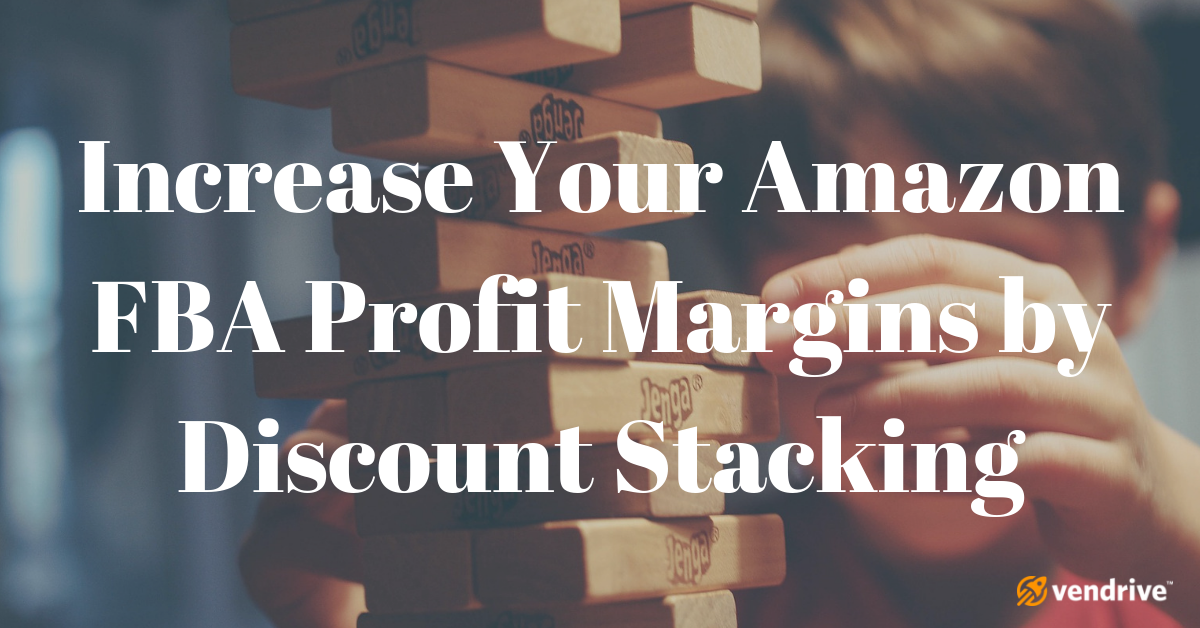
Arguably one of the most important steps to Amazon sales success is making sure you’ve gotten the rock-bottom price for your product.
This is a dynamic topic that involves looking at the task of getting the best price from a holistic perspective to quickly increase your Amazon FBA profit margins.
Discounts come in many forms. Knowing your suppliers, your products and your business will help you to capitalize on as many of them as possible.
Let’s take a look at the types of discounts and some of the more discreet ways to add value to the wholesale purchase price of any given item.
Thoroughly understanding each of these opportunities will enable you to stack these savings in a way that makes sense for your business and provides you with the greatest margin.
Take your time to consider the big picture to really understand the benefit of each of these commonly offered discounts and how they will impact your overall profits.

When you see your profit margins after stacking discounts..
Evaluate which ones will be of the greatest value to you and go after them. The key to success in stacking discounts is the same on Amazon as it is in every other facet of business—negotiate!
You won’t get what you don’t ask for, and you need to know what you want in order to ask for it effectively. If there’s room in the price for any reason, find it and go after it.
You can do this best by being well versed in the needs and conditions of both your supplier and yourself.
Here’s a look at the typical discounts offered and ways for you to increase your margins by tapping into them.
Supplier Direct Discounts
For wholesale purchases, start with the basic price reductions offered by any supplier. Use your relationship with an Amazon FBA wholesale Supplier, if you have one, as well as any understanding that you have of the current market dynamics to secure any of the following discounts:
1 – Volume: Offer to buy the requested number of units. Whenever you have the opportunity, leverage this position by buying larger volumes. The more you buy, the more you save, whether in terms of price per unit or in terms of economies of scale. Further long-term sales potential can also factor into this offer if it makes sense as a part of your ask.
2 – Early Buy: You understand the typical sales cycle of your product. Ordering these items well in advance (pre-ordering) helps the supplier plan its production and gives you a great deal. Look at the terms and use the capacity to plan to your advantage.
3 – Association Member: Depending on your industry, you may receive a discount if you belong to a given trade organization. The discounts aren’t usually automatic, though; be sure to request them. I’ve personally used this method to save an immediate 10% and another 5% after 3 months with an amazing supplier.
4 – Free Shipping: Free (prepaid) shipping will save hundreds, maybe even thousands of dollars off the final cost of an item. This is one value addition that, depending on the product, could make or break your margins.
5 – Direct Import: For higher volumes of product, the supplier may choose to import pallets of items directly to you from overseas. By cutting out the trip to a manufacturer’s warehouse, you and the supplier both save. An ideal version of this would be a supplier shipping directly from their manufacturer into Amazon’s warehouses, cutting out 2-4 middlemen along the way.
Product Discounts
1 – Defective allowance: A small discount on the total purchase ensures that the supplier won’t accept any returns. This may be a flat rate across all purchases or negotiated on a separate basis.
2 – Category: Specific products that the supplier wants to move may be discounted heavily to clear out inventory.
3 – Competitive: If there are multiple suppliers for a given product, knowing the situation of each may give you better leverage in negotiating the price on that product.
4 – Month-end/Year-End Discounts: To make their own sales quotas, a supplier may offer incentives at the end of a given month, sales quarter or year. Find your supplier’s sales cycle, and checking in at strategic times.
5 – Package Deals: By bundling different items from the same supplier, you can save. Simply, this increases the value and the volume of the business that you do with them.
Payment Discounts
1 – Cash payment: Rather than using a credit card or relying on the supplier’s credit, pay up front with a cash or check.
2 – NET Terms: If offered, NET 15, 30 or 60 terms may be a great way to save money. In any of these cases, the supplier will ship the product and give you x number of days to pay. While this isn’t technically a discount, if you can better use the money elsewhere within the NET payment terms to maximize your profit, money earned translates into money saved. Exercise caution with this option, though, as NET terms may be tempting and default can spiral quickly.
How to optimize discounts

You after becoming a discount stacking master!
Now that you know what’s typically on offer, it’s time to learn strategies for optimizing each of these discounts. As you prepare to negotiate the best deal, you need to factor in the value of each of the applicable discounts that you are offered and decide which ones will be of the greatest benefit. To understand the true cost and get the best price, get a good grasp on these three points:
1 – Know your supplier. If you’ve already built a solid relationship with your supplier, use it to your advantage. If you haven’t done that yet, now’s the time to get started. With suppliers who you know, take note of how they’ve structured discounts in the past.
If seasonal or market influences have impacted their sales in any way, factor that into your decision-making process. Also, if you have the advantage of time, check in periodically to see if different discounts are available.
Should any products that they supply come on offer, they may keep you in mind.
Nothing is better than a supplier calling you to offer an exclusive deal on a brand new product or product they’re looking to restrict sellers on.
Even if you are new to a given supplier, the potential to develop a long-term client relationship is fundamental to every business practice. Lay out what you can do together in the future if you consistently get a good deal on their products.
Make it clear, if other suppliers occupy the same product space, that you have researched their competition and are equally knowledgeable of what they can do for you as well.
2 – Know your product. For example, if you’re selling oatmeal dog shampoo, make sure that you have a good grasp on what flexibility you have and what kind of leverage you can wield in a negotiation.
If you also sell a related product that you purchase from the same supplier, bundle the purchase to combine savings that work for you. Assuming that you have a good handle on sales, combine this with the other volume discounts as long as you can move the inventory.
Use your knowledge of any types of cyclical or seasonal demands to bring your price lower when you can.
3 – Know your position. If you’re cash-strapped, for example, a ‘cash payment discount’ isn’t much of an option, but NET terms can make the difference only as long as they work well with the rest of your business model.
NET terms may be more attractive than the lower upfront cost of the same product from another supplier. If you can better position yourself by increasing the volume of units purchased, you can leverage your buying power in one of the most effective ways.
Constraining your cash flow to do this, however, won’t make sense.
Stack discounts in a way that works for your business
If free shipping will save you hundreds of dollars off the final cost of your purchase, prioritize it when you negotiate. Aggregate your purchases to capitalize on any discounts that are available without hurting your business if you are in a position to do so.
In the case of the oatmeal dog shampoo, successful negotiation might pan out in the following manner for an order of 1000 pieces coupled with an order of a related product, free shipping, and a trade association discount:
Initial product price: $6.00
Volume Discount for ordering 1000 pieces.: -$0.50
Savings from free shipping: -$0.35
Bundle discount for purchasing with the related product: -$0.30
Pet Products Trade Industry Discount: -$0.15
_______
Final Discounted Price: $4.70
Depending on what you charge for this oatmeal dog shampoo, stacking different discounts like those above can make the difference between a viable margin and one that won’t work.
In this case, a seasonal discount might not be worth asking for as it shouldn’t apply to the product in question, but placing a larger order to secure that volume discount might be doable.
So now that you know what you need to do and how to get what you want, get out there and strike some deals!
Know that these discounts can often get better with an emphasis on building and maintaining strong relationships with your FBA Amazon wholesale suppliers.
Once you’ve obtained these savings, incorporate what you’ve learned into subsequent purchases and plan other ways to maximize your future savings as you work to grow your FBA Amazon venture.






About The Author: Dillon Carter
Hi, with James, we're building Amazon tools that we wish we had when starting our own companies. We love tech, coffee, building systems and all things Amazon.
More posts by Dillon Carter